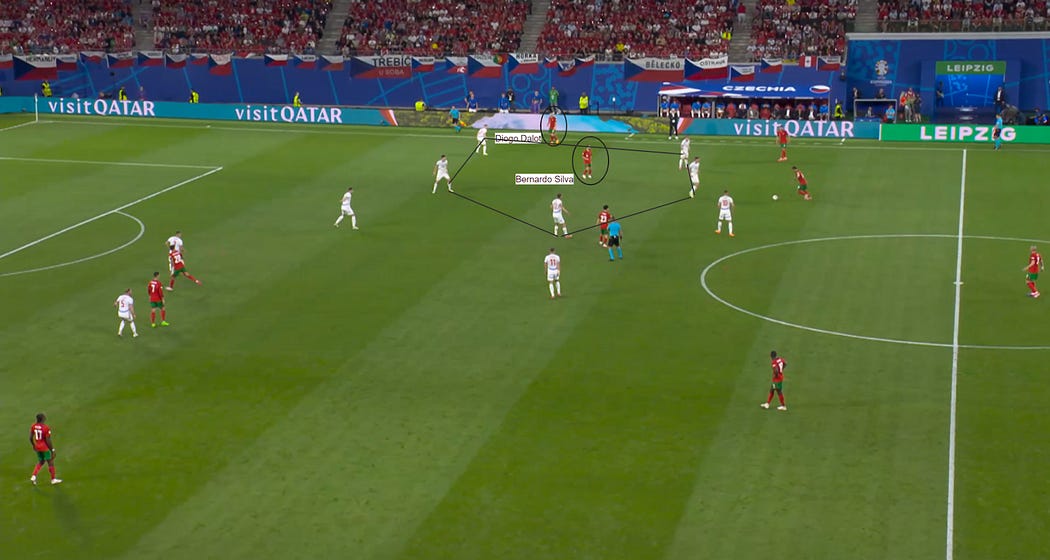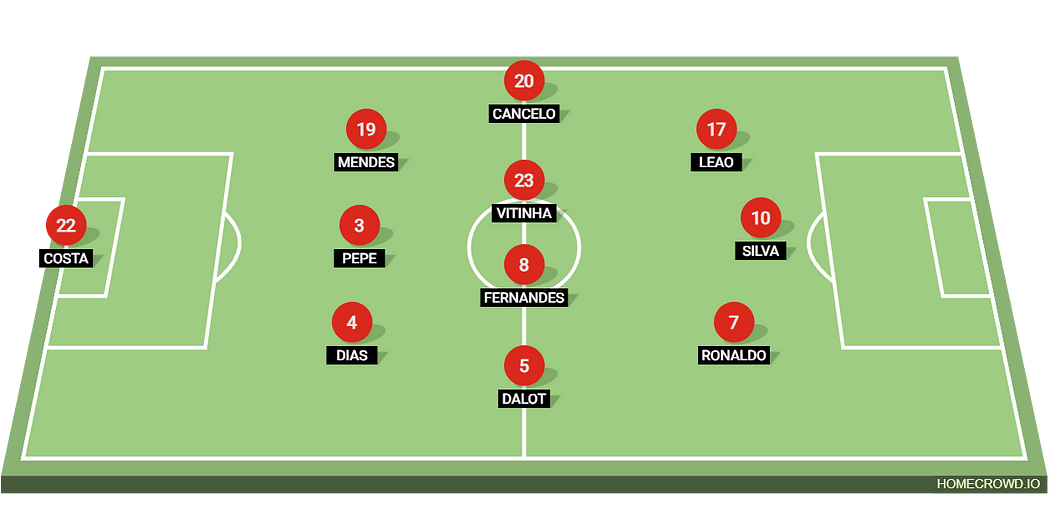Portugal Tactical Profile
Portugal provided some intriguing tactical tendencies in their opening victory over the Czech Republic. Some things worked & some things didn’t. I wanted to take a deeper look at the stylistic preferences Roberto Martínez has implemented in the side.
Out of possession
When the opponent has a goal-kick, or the ball is in the final 1/3rd, Portugal will set up in a 3–4–3. The key player in this setup is Bernardo Silva (#10). He is the player who leads & directs the press. He is often the first player to apply pressure & force the opponent to play in one direction…
The scenario changes, however, when the opponent has more controlled possession, or Portugal are unable to immediately force a turnover through their high pressure. If this is the case, Portugal will switch into a 5–3–2 system. The fullbacks drop deeper, and the midfield becomes quite flat.
Neither Rafael Leão (#17) nor Cristiano Ronaldo (#7) apply significant pressure. They do the bare minimum in closing down dangerous passing lanes, but a good centerback pairing can easily bypass them. Again, it is often Bernardo Silva (#10) who ends up becoming the first player to apply pressure on the opponent in possession.
The biggest weakness in this Portuguese midfield is their lack of attention to tracking runners & recovering when overplayed. The selection of Bruno Fernandes (#8), Bernardo Silva (#10), & Vitinha (#23) is very attacking, & it shows in their lack of attention to defensive details. A particular problem stemming from this midfield is Portugal’s inability to control the area on top of their penalty area. They often don’t track back with the necessary intensity to cut-out dangerous balls into this valuable scoring position.
Transition (In Possession to Out of Possession)
Against Czechia, Portugal displayed extremely impressive gegenpressing. This stems from their in-possession structure. Portugal move possession forward in unison, and attempt to play through tight spaces. When there is a turnover, Portugal have high numbers around the ball, and short distances between their defensive, midfield, & attacking player chains.
Even if the first man doesn’t win possession, his application of pressure will often force an uncontrolled pass that the second or third Portuguese player can profit from. In this way, Portugal managed to suffocate Czechia throughout most of the fixture and run them to the ground.
In Possession
In possession, Portugal opted for a very fluid 3–2–2–3. The 4-man midfield of João Cancelo, Vitinha (#23) Bruno Fernandes (#8), & Bernardo Silva (#10) were extremely positionally fluid. Particularly Bruno Fernandes (#8) & Bernardo Silva (#10) were given absolute freedom on the pitch, dropping to receive from the backline, or remaining high for a final third-entry passes.
The wide forwards in the system — Rafael Leão (#17) & Diogo Dalot (#5) — were tasked with staying extremely high & wide. They were asked to pin the opposition fullback into the backline, creating room in the half-spaces where Bruno Fernandes (#8) & Bernardo Silva (#10) could venture into.

This was an effective ploy, but it was also restricted throughout the match by the presence of Cristiano Ronaldo (#7). Rather than pin the centerbacks back, Ronaldo would often seek these half-spaces for himself, congesting the game and closing the key creative zones that should have been available for Bruno Fernandes (#8) & Bernardo Silva (#10).
In theory, this could have still worked, but Ronaldo’s decisions did not complement the qualities of Bruno Fernandes (#8) & Bernardo Silva (#10). Both Portuguese playmakers want the ball to feet, & Ronaldo’s off-ball movement was sacrificing the creative space in front of the Czechia backline in favor of space that could have been exploited with incisive runs behind it.
One player who theoretically does have the quality to exploit these moments is Rafael Leão (#17), however, the Milan winger’s timing & recognition for when to move in behind was often poor. Despite having the natural qualities to pose a threat with his off-ball movement, Leão still prefers to have the ball to his feet, a skill already in abundance in the Portuguese squad.
This, is ultimately why the introduction of Diogo Jota (#21) in the 63rd minute proved so impactful. The Liverpool winger was very selfless with his off-ball movement. He moved in behind when Ronaldo dropped deep and remained wide when he sensed that Bruno Fernandes (#8) or Bernardo Silva (#10) were seeking out the half-spaces.
Another important feature of Portugal’s in-possession structure were the differences between their progression on the right & left side of the pitch. Almost all of Portugal’s build-up came over the right side. They would frequently overload these zones to try and combine through with a numerical advantage.
On the other hand, Portugal would rarely remain on the left side of the pitch for very long. They also wouldn’t overload these areas to allow Rafael Leão (#17) an opportunity to isolate and take on an opponent 1v1.
Transition (Out of Possession to In Possession)
When Portugal win the ball against an opponent in an advanced possession shape, their first instinct is to find the feet of Bruno Fernandes (#8). He will always carry possession forward as far as possible, hoping to engage opponents and create openings.
The problem for Portugal lies, however, in the lack of impactful off-ball runs that can provide Bruno Fernandes (#8) with a clear pass towards goal. Often Bernardo Silva (#10) makes an intelligent run, but he lacks the raw speed & dynamism to accelerate past an opponent.
Stylistic Overview
Strengths
Collective movements in possession create short distances if the ball is turned over
Very coordinated & dominant gegenpressing & appreciation of pressing triggers
Impressive ball carrying from Bruno Fernandes (#8) & Bernardo Silva (#10) to exploit transitions
Ability to manipulate tight spaces in possession with large numerical advantages in tight corridors
Diogo Jota’s (#21) selfless movement & ability to create space for others following his introduction
Weaknesses
Poor application of first line pressure from strike-duo Cristiano Ronaldo (#7) & Rafael Leão (#17)
Poor recovery runs & transitions from the midfield to close the space on top of the penalty area
Cristiano Ronaldo’s deep movement that restricted central space in front of the opposition defense
The lack of lateral movement in-behind the backline; particularly from Rafael Leão (#17)
Portugal’s reliance on deep crosses without a good presence in the box or preparation








